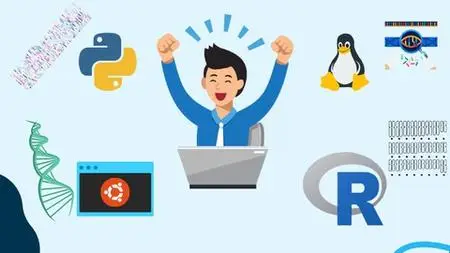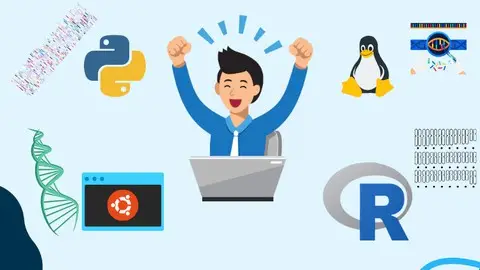Bioinformatics Scripting: Python, R, Linux For Data Analysis
Published 3/2024
MP4 | Video: h264, 1920x1080 | Audio: AAC, 44.1 KHz
Language: English | Size: 7.98 GB | Duration: 12h 12m
Published 3/2024
MP4 | Video: h264, 1920x1080 | Audio: AAC, 44.1 KHz
Language: English | Size: 7.98 GB | Duration: 12h 12m
Mastering Python, R, and Bash for Efficient Biological Data Processing and Analysis
What you'll learn
Fundamentals of Python, R, and Bash scripting: Learn the basics of these scripting languages, including syntax, data types, variables, and control structures.
Data parsing and manipulation: Understand how to parse and manipulate various biological data types, such as DNA sequences, protein structures, and gene express
Data visualization: Learn how to visualize biological data using Python and R, including creating plots, charts, and graphs to gain insights from the data.
Statistical analysis: Explore statistical analysis techniques in R for analyzing biological datasets, including hypothesis testing, regression analysis, and clu
Automation and pipeline development: Learn how to automate repetitive tasks and build efficient data processing pipelines using Bash scripting.
Real-life data analysis projects: Apply the skills learned throughout the course to real-life biological datasets, gaining hands-on experience in bioinformatics
Best practices in bioinformatics scripting: Learn best practices for writing clean, efficient, and maintainable scripts for bioinformatics analysis.
Requirements
Basic biology knowledge: Understanding of fundamental biological concepts such as DNA, genes, proteins, and biological processes.
Computer skills: Comfortable using a computer and basic software applications. No prior programming experience is required.
Command line familiarity: Basic familiarity with the command line interface (e.g., navigating directories, executing commands) will be helpful but is not mandatory.
Hardware and software requirements: Access to a computer with internet connectivity and the ability to install software (Python, R, and Bash) as needed for the course.
Description
Welcome to "Bioinformatics Scripting: From Data Parsing to Analysis," a comprehensive course designed to equip you with the essential skills in Python, R, and Bash scripting for effective biological data processing and analysis.In the rapidly evolving field of bioinformatics, the ability to efficiently analyze and interpret biological data is crucial. This course is designed to help you master the scripting languages commonly used in bioinformatics—Python, R, and Bash—and apply them to real-life biological datasets.The course begins with an introduction to the fundamentals of Python, R, and Bash scripting, including basic syntax, data structures, and control flow. You will then learn how to parse different types of biological data, such as DNA sequences, protein structures, and gene expression profiles, using these scripting languages.As you progress through the course, you will explore advanced topics such as data visualization, statistical analysis, and machine learning in Python and R. You will also learn how to automate repetitive tasks and build efficient data processing pipelines using Bash scripting.By the end of the course, you will have the skills and confidence to tackle complex bioinformatics problems and conduct meaningful analyses of biological data. Whether you are a biologist looking to enhance your computational skills or a programmer interested in applying your skills to biological research, this course will provide you with the knowledge and tools you need to succeed in the field of bioinformatics.Join us on this exciting journey and take your bioinformatics skills to the next level!
Overview
Section 1: Introduction
Lecture 1 Introduction to bioinformatics scripting
Section 2: Introduction to bash for bioinformatics
Lecture 2 Introduction to linux (bash for bioinformatics)
Lecture 3 Bash Basic Commands
Lecture 4 Ncbi E-utilities on bash (Sequence Analysis)
Lecture 5 Famous Bioinformatics Tools (Installation and Introduction)
Lecture 6 Blast for Linux (Sequences Homology)
Lecture 7 Sequence Alignment Analysis
Lecture 8 Phylogenetic Analysis (Tree Construction)
Lecture 9 GitHub Repository
Section 3: GitHub for Bioinformatics (Not Compulsory)
Lecture 10 Introducing GitHub
Lecture 11 Profile and first Repository Setup
Lecture 12 Bioinformatics Projects Hunting
Lecture 13 Cloning and Forking Repositories
Lecture 14 Collaborating on GitHub
Lecture 15 GitHub for Project Mangement
Section 4: CLI in Bioinformatics (Not Compulsory)
Lecture 16 Introduction and Why CLI in Bioinformatics
Lecture 17 CLI and GUI Explanation
Lecture 18 if we already have Graphical user interface system why we should use CLI?
Lecture 19 Short Practical with Programming Language
Lecture 20 Why Would You Use CLI over GUI?
Lecture 21 Foundation behind CLI Shell explanation
Lecture 22 Drawbacks of CLI and GUI
Lecture 23 Linux Introduction and Usage Over years
Lecture 24 Linux Distros
Lecture 25 Why Ubuntu Operating System
Lecture 26 WSL Explanation
Lecture 27 Linux Vs Unix
Section 5: WSL as Linux Alternative on Windows
Lecture 28 (Practical) Making A Subsystem For Linux In Windows OS
Lecture 29 Linux File Handling Commands
Lecture 30 Accessing And Creating Files In Windows Os
Lecture 31 Basic Process Management Commands for Linux OS
Lecture 32 E-Direct Introduction
Lecture 33 Installing NCBI through CLi
Lecture 34 Code Used in Lectures
Lecture 35 Entrez Direct Functions
Lecture 36 Mrna And Protein Seq Retrieval
Lecture 37 Batch Retrieval of Protein Using Taxon Id
Lecture 38 Retrieving CDS From Reference Genome
Lecture 39 Explaining Different Commands
Section 6: Bioinformatics Pipeline
Lecture 40 Pipeline Explanation
Section 7: NGS data Analysis on Bash
Lecture 41 Introduction
Lecture 42 Getting the SRA Reads
Lecture 43 Checking the Quality of Data
Lecture 44 Quality Trimming of data
Lecture 45 Aligners and Aligning Reads to genome
Lecture 46 SAM and Bam File Indexing and Sorting
Lecture 47 Feature Extraction
Lecture 48 Pipeline Code
Section 8: Variant Calling analysis on Bash
Lecture 49 Introduction
Lecture 50 Variants and Types
Lecture 51 Understanding the Metadata and Softwares
Lecture 52 Getting Data From SRA Using SRA Toolkit
Lecture 53 Quality Control and Trimming
Lecture 54 Sam and Bcf Tools and Fixing NS and Calling Variants
Lecture 55 Alignment to Reference Genome
Lecture 56 Separation of SNP's and Indels Variants
Lecture 57 Visualizing Variants Using IGV and UCSC Browser
Lecture 58 Pipeline Code
Section 9: Python Section
Lecture 59 Introduction to Bioinformatics and Why Python
Lecture 60 BioPython Introduction
Lecture 61 GitHub Repository for Python
Lecture 62 Setting up Coding Environment
Lecture 63 Explaining the libraries for the course
Lecture 64 Advance File Formats of Bioinformatics with BioPython
Lecture 65 Sequence Analysis Using Biopython
Lecture 66 Database Retrieval/Accessing Using Biopython
Lecture 67 Working With Genomes Using Biopython
Lecture 68 Phylogenetic Tree Construction using Biopython
Lecture 69 Proteomics Analysis Using Biopython
Lecture 70 Machine Learning in Bioinformatics
Section 10: R Section
Lecture 71 Introduction to Bioinformatics and R: Exploring the Intersection of Biology
Lecture 72 Getting Started with R: Installation and Variables Understanding
Lecture 73 Working with R Packages: Installing, Loading, and Exploring Bioinformatics
Lecture 74 Differential Gene Expression Analysis with Deseq2: Preparing Data
Lecture 75 Deseq2 Code Understanding
Lecture 76 Converting Ensembl Gene IDs to Gene Symbols: Using R Techniques and Packages
Lecture 77 Visualizing Gene Expression Data: Creating Stunning Plots with ggplot2
Lecture 78 Introduction to Single-Cell RNA Sequencing (scRNA-seq) Data Analysis
Lecture 79 Exploring scRNA-seq Code: Cell Trajectories and Gene Expression Dynamics
Lecture 80 GitHub Source Code for R
Section 11: Microarray Data Analysis Using R
Lecture 81 Introduction of Microarray
Lecture 82 Microarray Databases
Lecture 83 Microarray Analysis Using GEO2R
Lecture 84 Microarray Analysis on R
Lecture 85 Source Code for Microarray Section
Section 12: Thank You for taking the Course
Lecture 86 Thankyou Note
Biologists: Biologists who want to enhance their computational skills and learn how to analyze biological data using scripting languages.,Programmers: Programmers interested in applying their skills to biological research and learning about the unique challenges of bioinformatics data analysis.,Students: Students studying bioinformatics, biology, computer science, or related fields who want to gain practical skills in bioinformatics scripting.,Professionals: Professionals working in the field of bioinformatics who want to update their skills and learn new techniques for data analysis.,Anyone interested in bioinformatics: Individuals with a general interest in bioinformatics and a desire to learn more about how biological data is analyzed using scripting languages.



